
※High purity exosomes can be easily isolated by PS affinity method.

High purity and intact exosomes

High reproducibility
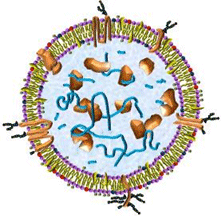
| Methods | Exosome purity | Recovery amount | Intact or not | Total Protein yield |
|---|---|---|---|---|
| MagCapture™ (PS affinity method) |
■ ■ ■ ■ | ■ ■ ■ | Yes | ■ |
| Ultracentrifugation | ■ ■ | ■ ■ | Yes | ■ ■ ■ |
| Polymer-based precipitation | ■ | ■ ■ | Yes | ■ ■ ■ ■ |
| Density gradient centrifugation method | ■ ■ ■ | ■ | Yes | ■ ■ |
| Size fractionation method | ■ ■ ■ | ■ ■ | Yes | ■ ■ |
| Exosome surface antigen affinity method (using the antibody) |
■ ■ ■ | ■ ■ | No | No data |
※This comparison table is based on our own survey. Since the results vary depending on a sample, a detection target and method, the performance of each method is not guaranteed.
This is the section to prepare samples. When exosomes and other large EVs (microvesicles) are needed, prepare 1,200 x g supernatant ※ 1 as a sample.
Additionally, when highly purified exosomes are needed, prepare 10,000 x g supernatant ※ 2 as a sample. This protocol for sample preparation is set for cell culture medium, serum, and plasma. When other body fluids are used, please examine the appropriate preprocessing protocol by referring to the protocol for serum and plasma.
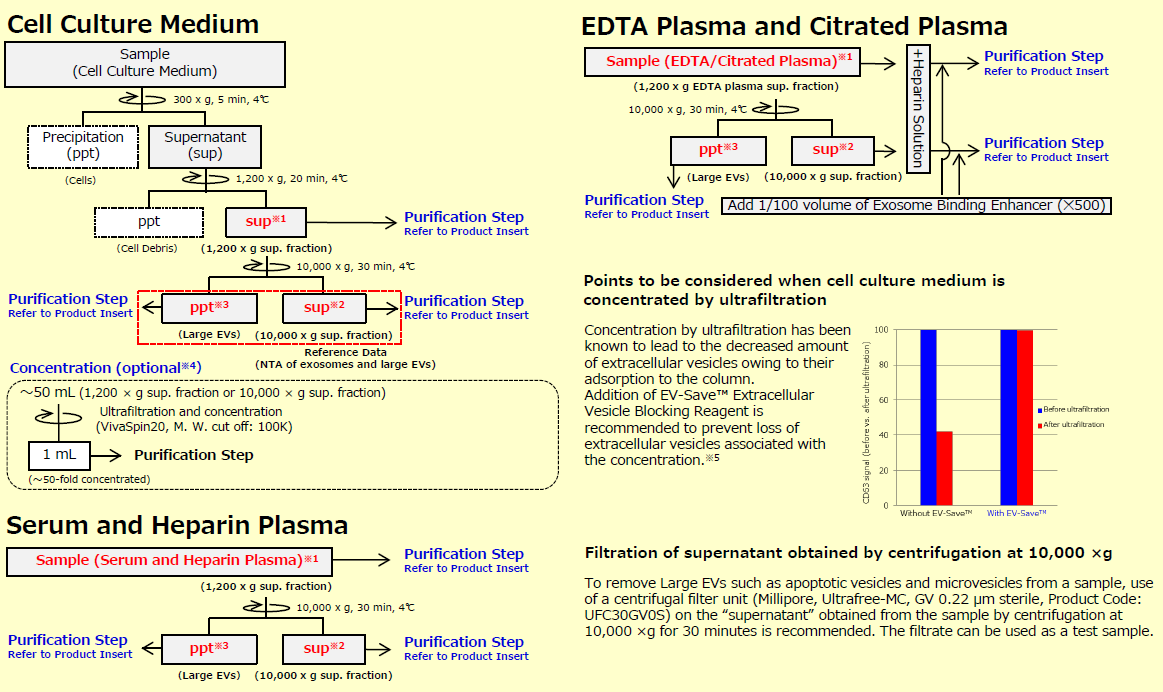
※1 When exosomes and large EVs are needed, use 1,200 x g sup. franction as sample.
※2 When exosomes are needed, use 10,000 x g sup. fraction as sample.
※3 When Large EVs are needed, use ppt of Large EVs obtained by centrifugation at 10,000 x g as sample after suspending it with TBS.
※4 The concentration step is an option when using a large volume (~ 50 mL) of cell culture supernatant as a sample for purification. However, since recovery efficiency improves, please perform it as much as possible.
※5 Because EV-Save™ contains polymers, its use is not recommended for preparation of proteomic analysis samples.
The concentration of the sample is recommended when using a large volume (~50 mL) of cell culture supernatant as a sample for purification. Since recovery efficiency improves, please perform it as much as possible.
Add the appropriate volume of TBS into samples to reach the volume of 0.5 mL to obtain the better mixture of the Exosome Capture-immobilized beads with the sample. (Example: 100-200 μL → 500 μL)
1 mL of K562 cell culture supernatant (collected after stimulating exosome secretion with monensin sodium salt) was centrifuged at 10,000 x g to isolate supernatant and precipitate (suspended with 1 mL of TBS) fractions.
Then, extracellular vesicles were purified from both fractions with MagCapture™ Exosome Isolation Kit PS and analyzed using NanoSight LM10.
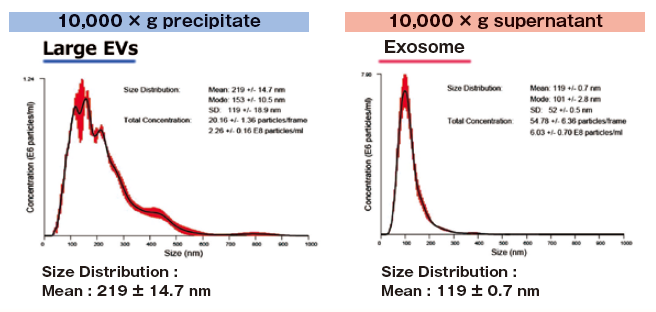
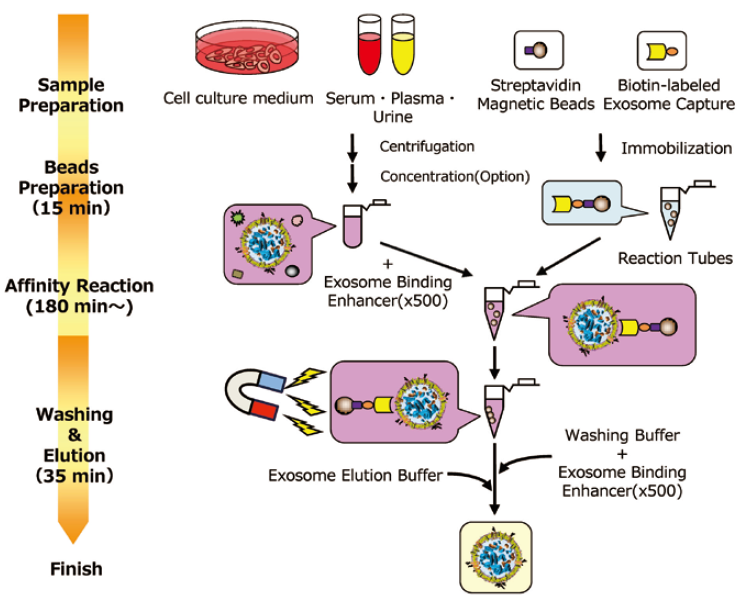
Exosomes were isolated from normal human serum by using MagCapture™, ultracentrifugation and affinity method with antibody against surface antigen of exosome, followed by Western Blot with the anti-CD9 and anti-CD63 antibodies.
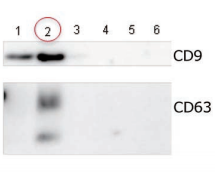 |
Lane 1: Ultracentrifugation Lane 2: MagCapture™ Lane 3: Exosome Isolation reagent with antibody against CD9 [Supplier A] Lane 4: Exosome Isolation reagent with antibody against CD63 [Supplier A] Lane 5: Exosome Isolation reagent with antibody against CD81 [Supplier A] Lane 6: Exosome Isolation reagent with antibodies [Supplier A] (antibody beads-mixture of CD9, CD63, CD81 & EpCAM) |
Detection antibodyAnti-CD9 rabbit pAb, System BioscienceAnti-CD63 rabbit pAb, System Bioscience About data of WBEach signal corresponds to 150μL of the serum sample. 15μL of eluate and 5μL of 4×SDS sample buffer were mixed and applied all in each well. |
The yield of exosomes by MagCapture™ is higher than ultracentrifugation and the antibody-based method.
Exosomes were isolated from EDTA-plasma, EDTA-plasma (buffer-exchanged), and serum by using MagCapture™, followed by Western Blot with the anti-Flotillin-2 antibody.
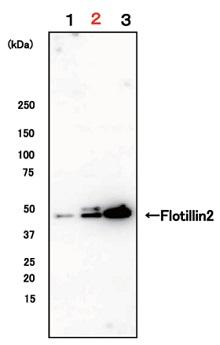 |
Lane 1: EDTA-plasma Lane 2: EDTA-plasma (buffer-exchanged) Lane 3: Serum |
Detection antibodyAnti-Flotillin-2 mouse mAb (29/Flotillin-2), BD BioscienceSample volume1 mL eachAbout data of WBEach signal corresponds to 150μL of various samples. 15μL of eluate and 5μL of 4×SDS sample buffer were mixed and applied all in each well. |
By exchanging buffer by ultrafiltration, exosomes can be isolated more efficiently.
Exosomes were isolated from normal human urine by using MagCapture™, ultracentrifugation and polymerbased precipitation, followed by Western Blot with the anti-CD9 antibody.
 |
Lane 1: Polymer-based precipitation Lane 2: Ultracentrifugation Lane 3:Mag Capture™ |
Detection antibodyAnti-CD9 rabbit pAb, System BioscienceSample volume1 mL eachAbout data of WBEach signal corresponds to 150μL of the urine sample. 15μL of eluate and 5μL of 4×SDS sample buffer were mixed and applied all in each well. |
 |
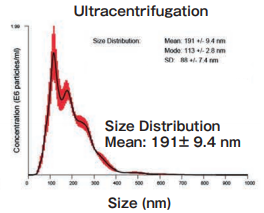 |
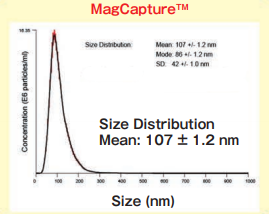 |
||
Size DistributionMean: 176 +/- 1.6 nmMode: 117 +/- 4.5 nm SD: 96 +/- 5.8 nm |
Size DistributionMean: 191 +/- 9.4 nmMode: 113 +/- 2.8 nm SD: 88 +/- 7.4 nm |
Size DistributionMean: 107 +/- 1.2 nmMode: 86 +/- 1.2 nm SD: 42 +/- 1.0 nm |
High purity exosomes can be isolated from urine sample.
The yield and purity were compared for exosomes isolated from K562 (human chronic mylogenous leukemia: CML) cell culture supernatants (serum-free medium, or 10% Exosome-depleted FBS medium) by using MagCapture™, ultracentrifugation and polymer-based precipitation method.
Exosomes were recovered from 1 mL of pretreated (10,000×g, 30 min.) cell culture supernatant of K562 cells (serum-free medium or 10% exosome-depleted FBS ※ 1 included medium) by using PS affinity method's standard protocol (reaction time: 3 hours)
10 mL of pretreated (10,000×g, 30 min.) cell culture supernatant of K562 cells (serum-free medium or 10% exosome-depleted FBS ※ 1 included medium) were ultracentrifuged at 110,000×g, 70 min., and the precipitates were suspended with TBS. Then, the suspension was ultracentrifuged again and the precipitated pellet was recovered as exosome sample.
Exosomes were collected from 1 mL of pretreated (10,000×g, 30 min.) cell culture supernatant of K562 cells (serum-free medium or 10% exosome-depleted FBS※1 included medium) by Supplier A’s product in accordance with manual (Precipitation time: overnight).
※1: Centrifuged for 2 hours at 110,000 × g, and the supernatant was collected so as not to take up the precipitate.
The particle size of exosomes from K562 cell culture supernatant (serum-free medium) using MagCapture™, ultracentrifugation and polymer-based precipitation, respectively was determined by using NanoSight LM-10. The collected exosomes (2-4 x 1010 particles) were fixed by 2% paraformaldehyde and analyzed by electron microscopy.
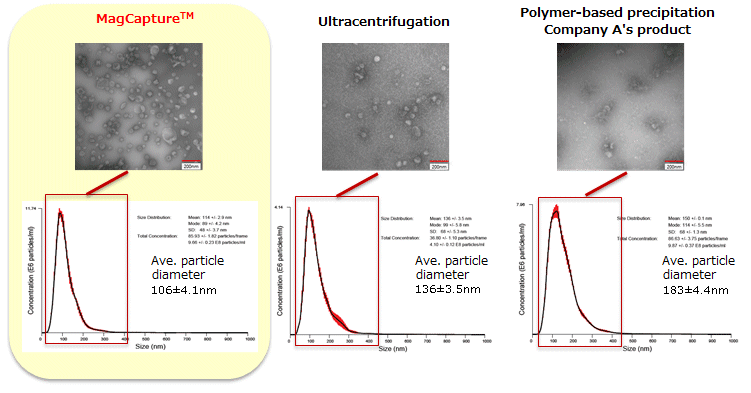
Electron microscope images were provided by Dr. R. Hanayama at Graduate School of Medicine, Kanazawa University and Dr. Nakai at iFReC, Osaka University.
MagCapture™ collected many particles around 50-100 nm in size. With electron microscopy, numerous extracellular vesicles can be seen.
Exosomes were collected from cell culture supernatant of K562 cells (serum-free medium) by MagCapture™, ultracentrifugation and polymer-based precipitation. The recovery amount and purity were analyzed by silver staining and Western Blot with anti-CD63, anti-Flotillin-2, and anti-Lamp-1 antibodies.
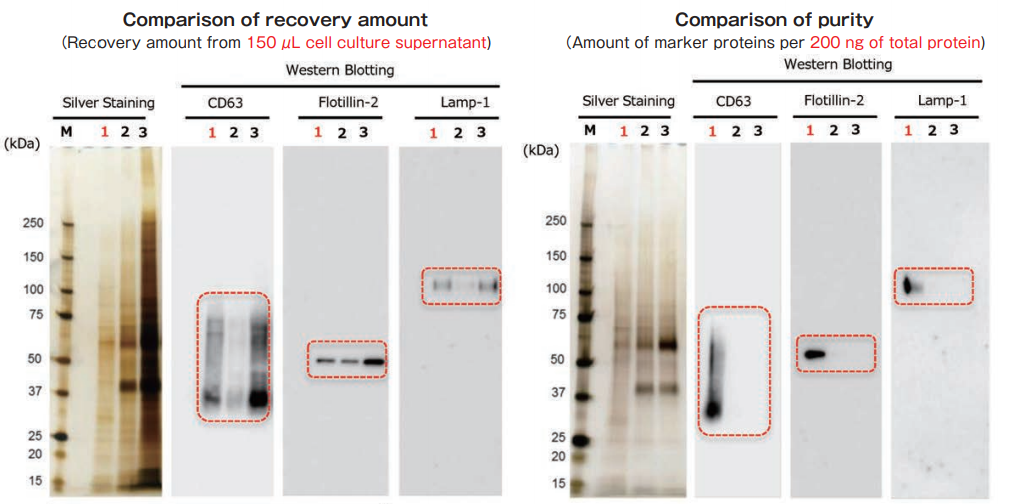
With MagCapture™, the recovery performance of exosomes is excellent and the amount of contaminant of proteins is very low, thus the balance of purity and recovery amount is the best.
The exosomes were collected from cell culture supernatant of K562 cells (10% exosome-depleted FBS included medium) by MagCapture™, ultracentrifugation and polymer-based precipitation. The recovery amount and purity were analyzed by silver staining and Western Blot with anti-CD63, anti-Lamp-1, and anti-Flotillin-2 antibodies. Furthermore, collected samples by each method were analyzed by mass spectrometry and compared the percentage of human-derived peptides from K562 cells.
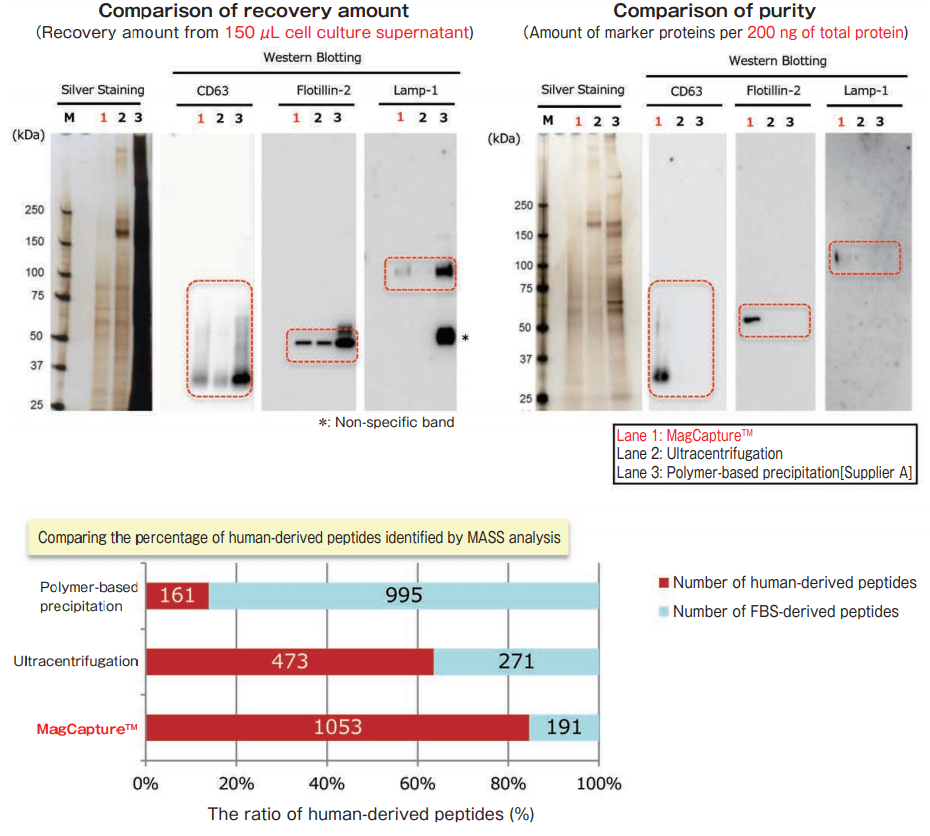
MASS analysis data was provided by Dr. R. Hanayama at Graduate School of Medicine, Kanazawa University and Dr. W. Nakai at iFReC Osaka University.
With MagCapture™, high purity exosomes are recovered even from culture medium with FBS, thus MASS analysis can be done with low background.
After isolation of exosomes from normal human serum samples by ultracentrifugation and the PS affinity method, RNA was recovered using microRNA Extractor SP Kit (Code No. 295-71701). microRNA (let-7a, miR-16, miR-92a, miR-142-3p) and mRNA (GAPDH, PIK3CB) were determined by quantitative PCR and compared it using Ct values.
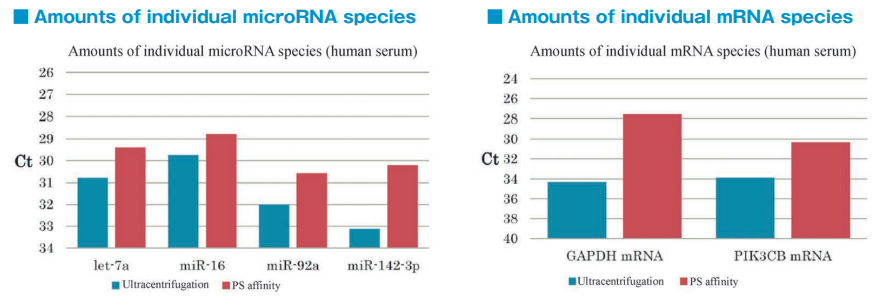
microRNA and mRNA were recovered more efficiently from exosomes isolated by the PS affinity method than those isolated by ultracentrifugation.
After isolation of exosomes from normal human serum samples by the PS affinity method, RNA was recovered using microRNA Extractor SP Kit (Code No. 295-71701) or acid guanidinium thiocyanate-phenolchloroform extraction (AGPC method). microRNA (let-7a, miR-16, miR-92a, miR-142-3p) and mRNA (GAPDH, PIK3CB) were determined by quantitative PCR and compared it using Ct values.

microRNA and mRNA were recovered more efficiently from exosomes using microRNA Extractor SP Kit than using AGPC method.
Exosomes were purified from K562 cell culture supernatant containing 10% exosome-free FBS using either the PS affinity method, ultracentrifugation, or polymer precipitation. The obtained exosome samples were separated by 10% polyacrylamide gel electrophoresis and the individual whole protein bands were cut out. After in-gel digestion, proteins were identified by liquid chromatography mass spectrometry (LC-MS). Proteins identified in exosome preparations purified by the 3 different methods (n=3 for each method) were also compared for Pair-wise correlations.
White columns: human protein derived from EVs
Gray columns: bovine protein contaminants derived from FBS
Red color: marker proteins of EVs
Sample: K562 cell culture Sup. (10% exosome-depleted FBS included)
| PS Affinity | Ultracentrifugation | Polymer Precipitation | |
|---|---|---|---|
| 1 | Heat shock cognate 71 kDa Protein | DNA-dependent protein kinase catalytic subunit | Complement C3 |
| 2 | Annexin A6 | Transferrin receptor protein 1 | Alpha-2-macroglobulin |
| 3 | Transferrin receptor protein 1 | Serum albumin | Fibronectin |
| 4 | V-type proton ATPase catalytic subunit A | ATP-dependent RNA helicase A | Serum albumin |
| 5 | Flotiillin-2 | Tubulin beta-5 chain | Thrombospondin-1 |
| 6 | Programmed cell death 6-interacting protein | Heat shock cognate 71 kDa protein | Complement C4 |
| 7 | 4F2 cell-surface antigen heavy chain | Fatty acid synthase | Alpha-1-antiproteinase |
| 8 | Annexin A1 | 4F2 cell-surface antigen heavy chain | Apolipoprotein B-100 |
| 9 | Kinase D-interacting substrate of 220 kDa | U5 small nuclear ribonucleoprotein helicase | Hemoglobin fetal subunit beta |
| 10 | Annexin A2 | Tubulin beta-4B chain | Tubulin beta-5 chain |
While proteins of bovine serum origin are present in the greater amount of exosome preparations obtained by polymer precipitation, more exosome marker proteins are identified in exosome preparations obtained by the PS affinity method.
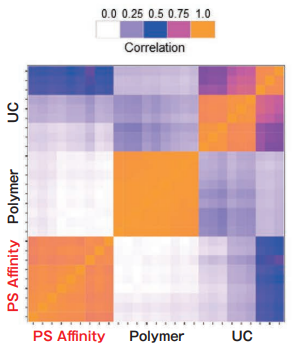
Sample: K562 cell culture Sup. (10% exosome-depleted FBS included)
| Reproducibility | |
|---|---|
| Ultracentrifugation (UC) | △ |
| Polymer Precipitation | ○ |
| PS Affinity | ○ |
Reference: Sci Rep. 2016 Sep 23;6:33935. Nakai W et al.
Polymer precipitation and the PS affinity method exhibit high intra-method correlation, while the intra-method correlation for ultracentrifugation is a little bit lower. Inter-method correlations between different methods are relatively low. The different purification methods might yield different exosome populations.
PProtein Assay BCA Kit, capable of assaying total protein concentration in solution using bicinchoninic acid (BCA), is the most widely used protein assay kit. It is based on the principle of reduction of Cu2+ to Cu+ by protein under basic conditions. Chelate formation between Cu+ and BCA generates a purple-colored chelate. Since the purple color becomes more intense in proportion with protein concentration, the protein concentration is determined by comparing this absorbance at 562 nm with a standard curve of absorbance from varying bovine serum albumin (BSA).
Here, the protein concentration in an exosome preparation purified from cell culture supernatant using MagCapture™ Exosome Isolation Kit PS was determined according to the high-sensitivity protocol for Protein Assay BCA Kit.
An exosome solution purified using MagCapture™ Exosome Isolation Kit PS pipetted into a 96-well plate in 25 μL aliquots and then 200μL of a mixture of Reagent A and Reagent B included in Protein Assay BCA Kit was added to each well. After subsequent incubation at 60℃ for 30 minutes, the absorbance was measured at 560 nm (Figure 1). The result demonstrated that the protein concentration in a purified exosome preparation was able to determine using the high-sensitivity protocol for Protein Assay BCA Kit.

Figure 1. A BSA calibration curve determined using Protein Assay BCA Kit and assay of protein concentration of a purified exosome preparation
Since protein concentrations of exosome preparations are rather low, use undiluted samples for BCA protein assay.
Exosomes purified by MagCapture™ Exosome Isolation Kit PS were labeled with PKH67 (Sigma) and confirmed their ability to be incorporated into HeLa cells.
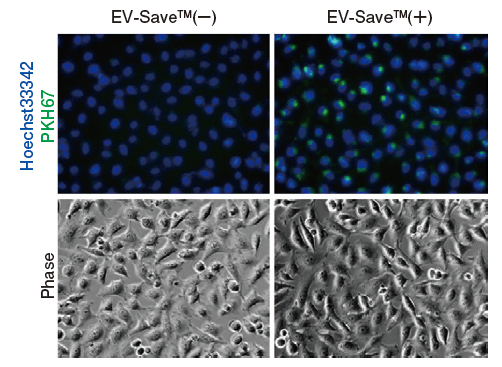
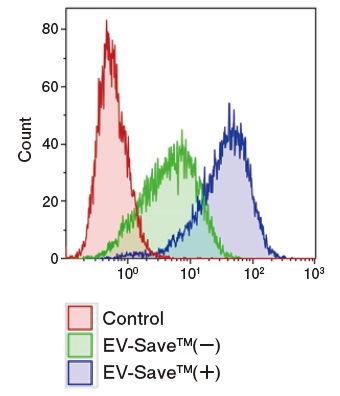
Figure 1. Observation of the uptake of PKH-labeled exosomes into HeLa cells. Exosomes were isolated from COLO201 cell conditioned medium using MagCapture™ Exosome Isolation Kit PS (total protein 3 μg, particle number 1 x 1010), followed by labeling using PKH67 Green Fluorescent Cell Linker Kit (Sigma). The uptake of the labeled exosomes into HeLa cells was confirmed by fluorescence microscopy (left) and flow cytometry (right).
Now you can see that PKH67-labeled exosomes are incorporated th rough endocytosis in both microscopy image and flow cytometry chart. Also, you can find that EV-Save™ Extracellular Vesicle Blocking Reagent added to the sample remarkably reduced the loss due to adsorption to the gel filtration column in a dye-removal step.